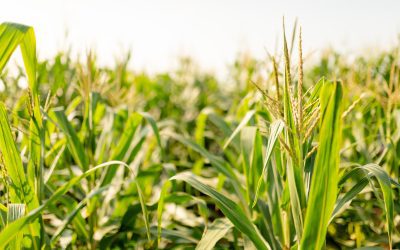At the July 27 Ag Policy Summit, presented by the Indiana Corn Growers Association (ICGA) and Indiana Soybean Alliance Membership and Policy Committee (M&P), carbon credit markets and the complexities associated with understanding them was a hot topic that spurred many questions from attendees.
Ben Gordon, the Carbon and Ecosystem Services Global Portfolio Leader with Corteva Agriscience, was the source at the Summit to answer those questions.
“I think this is a really important piece for farmers when you think about how society regards agriculture and talking about climate change,” Gordon said. “This is a great opportunity to be on our front foot and engage. Anytime when we’re talking about selling revenue, I think that gets me a heck of a lot more excited than having to add another cost to the farm.”
Gordon advised that carbon credits should be about running a farm effectively and with good agronomic principles rather than plunging into a new, over-hyped, high-risk venture. “It should just be another part, another revenue stream, another set of tools that you have to run your operation,” he said.

The interest in newer carbon markets – unlike similar conversations in the past – involve governments or companies that have made commitments to help curb climate change. Typically, these commitments are a forced condition, mandated by investors in those companies. The concept of carbon credits in agriculture works as a method of connecting those companies with a tool to honor those commitments.
Gordon said the ag industry is fortunate to be part of a solution because opportunities within ag – such as changes in farming practices – are something that can be implemented immediately, versus other, long-term and large-scale solutions. However, he cautioned that different carbon credit programs and contracts are not one-sizefits-all. A farmer needs to find the program that makes the most sense for their operation agronomically, specifically in terms of new programs.
Outcomes, not practices
“In our program, we pay based on outcomes, not on practices,” Gordon said. “The reason is we want to help farmers maintain their agronomic flexibility. So, first thing is we need to choose the right practice on the right acreage.”
In Corteva’s program, that means in-depth soil sampling obtained by using hydraulics to pull high-density cores, along with data from digital tools to quantify the amount of carbon being sequestered or the greenhouse gasses that are reduced through management practices. Before enrolling in a carbon credits program, Gordon urges farmers to consider these questions: Am I getting a fair deal? What is the level of effort? And most importantly – what is the contractual flexibility?
“We do think about what’s in it for farmers. I’ve said it once, and I’ll say it again: When we have these conversations, think agronomy, agronomy, agronomy, and then we can talk about carbon markets,” he said. “What is the type of credit being generated? Is it a real asset that is certified, or is it just a company that’s saying ‘hey, we’re putting our stamp of approval on the stuff we’re going to buy, and you’re stuck with us forever?’”
How do farmers know they are getting a fair deal in a carbon credits program? Gordon advised that agronomy needs to come first in order to reap benefits. American farmers can expect roughly $17 to $25 per acre in modern carbon programs. However, the change in practice itself may cost just as much. For example, adding cover crops to fields may cost somewhere between $30 and $35 per acre.
“You need to do that math if you’re on the fence with these practices,” he said. “One thing I will mention though is that we do expect these prices to increase.”
In Europe, carbon credit prices are much higher, which is what Gordon predicts will happen eventually in the United States.
“I mean look at Europe right now where it’s 50-60 Euros per ton,” he said. “That’s roughly $70-$80 per ton. Now you’re talking $40-$50 per acre. And if you look at offsets required for only half of the corporate commitments out there, you could see pricing that’s in that $50-$100 range. So, we want to make sure we are keeping our eyes wide open and not jumping into anything too fast, but also maintaining the ability to capture that upside for the industry and for our customers.”
Financial freedom to experiment
If a farmer does attempt these practices, companies like Corteva can help de-risk and accelerate that change. Under the right circumstances, Gordon said, participation in a carbon program can give farmers financial freedom through these incentives to experiment and explore what will make sense for them from an overall agronomic perspective.
Gordon said it is important that the level of effort to participate in a given program is not more than it is worth. “You need to become full-sharing of the data under your control, and maintain and understand exactly who gets it, as well as the level of support that exists,” he said. “We’re not asking farmers to do 25 hours of data entry when they’re already pretty darn busy.”
Contractual flexibility should be of the utmost concern for farmers looking into carbon credit programs. The level of commitment, agronomic flexibility and the ability to switch buyers are some of the factors to consider, Gordon said.
“You should know the parameters you’re committed to,” he said. “If you do go out in the spring and there are ruts in the field, can you actually go till that? Or is that something you are not permitted to do? A lot of these contracts don’t have the flexibility and the teeth in them to hold these companies accountable so that farmers can get the upsides of these markets and don’t have to switch to another buyer.”
But there is an “elephant in the room” Gordon said. Producers who have been adopting carbon-sequestering practices and using cover crops for years will not be eligible for most programs.
“Our program, like many others, does require net new practice change,” he said. “That isn’t necessarily too favorable, but at its core, the reason we have this new net practice change for eligibility is directly tied to us being able to tap into that net revenue for the industry and those new dollars.”
Gordon said the people and corporations who are making financial commitments and spending those dollars in ag want their dollar to directly drive the change, and that there is a whole new set of climate accounting rules.
“I think if we run into another spell – and we will – of lower commodity prices, we need to increase the buffer that our producers have out there to be rewarded for the outcomes that they are generating because the farmers are first stewards of the land,” Gordon said. “I believe that whole-heartedly. I would just like to pay farmers for it.”



